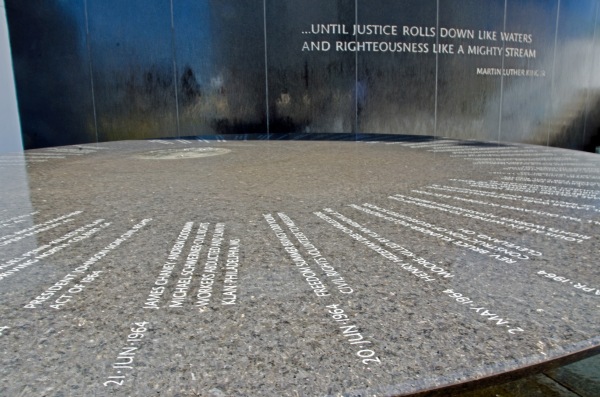His murderers had every reason to believe that Emmett Till would simply vanish beneath the water like so many other ‘negros’ had. Mutilated, beaten, and shot in the head, his body was discovered bound with barbed wire to a 70-pound cotton gin fan at the bottom of the Tallahatchie River. The 14-year-old boy’s crime: allegedly flirting with a white woman.
His mother had different ideas, though. Insisting on an open casket funeral, she forced the country to face the horrors of our ‘separate but equal’ society. Far from lost, Emmett became a rallying cry for change and is now remembered, along with 39 other victims and heroes, at the Civil Rights Memorial in Montgomery, Alabama.
It is hard to believe that just fifty short years ago the ugliness of that era was accepted as normal. That murder, torture, and intimidation were believed by many to be justifiable means to preserve unjust ends. Many of these crimes were never even prosecuted. Criminals walked free because of indifference toward the victims.
But the memorial became more than just a reminder; it became a spur to justice. In recent years, several states – some armed with research conducted for the memorial – reopened cold cases, brought new charges, and garnered convictions for crimes committed decades earlier. It’s a testament to how far we’ve come.
But the Southern Poverty Law Center that sponsors this memorial reminds us there is more to do. Over 1,000 hate groups remain active in the United States today. A guard is posted at the memorial to prevent vandalism. As a society, we’re still debating whether certain of our citizens have the right to marry or serve openly in the military. The ‘promised land,’ while closer than ever, remains elusive.





















I have wanted to see the Civil Rights Memorial for as long as I can remember. I am glad that you were moved by it and I appreciated your comments. What fascinated me about it in my reading is the concept of touching the water flowing over the stone, causing a ripple that temporarily alters the course of the water. What a metaphor for the Civil Rights movement by Maya Lin. Thanks!
LikeLike
Hi Sarah, thanks for your comments. If I have one regret about this post, it is that I didn’t write enough about the memorial itself . . . the names and events from the 14 years between the Brown v. Board decision & Martin Luther King Jr’s assassination inscribed on a granite clock face marking the accomplishments and the sacrifices, but never reaching full conclusion, submerged under a perpetual stream of water . . . it’s an elegant and effective design (affective, too). I also didn’t touch on MLK’s church, just blocks away, or the State Capital, the site of many Civil Rights marches, or Rosa Parks bus stop, just a bit down the street.
It’s pretty powerful stuff and an important reminder of things that shouldn’t be forgotten.
LikeLike
I enjoyed reading this post. When we (finally) go fulltime, one of my goals is to do a Civil Rights tour. I’d like to see all the major sites like the Edmund Pettus Bridge and go to the various memorials and museums. I’ve been to the Lorraine Motel in Memphis but didn’t have time to go into the museum, so that is at the top of my list. I’ve always been fascinated by the story of Viola Liuzzo so I really want to visit the historic marker in Alabama that pays tribute to her. You may be near that, but I’ve heard it’s not easy to find. She is one of the 39 names on the memorial you visited.
Anyway…thanks for the post. We’ve come a long way but sometimes lately it seems like we are regressing a bit.
LikeLike
Hi Pam. We visited several of the major Civil Rights sites in Montgomery but didn’t get to Selma. And we didn’t even know to look for the marker where Viola was gunned down. It’s inspiring to learn about people like her, who risked everything even though it technically wasn’t her fight. She could have stayed out of the fray, and lived a long comfortable life. But she chose to stand up for what is right and it cost her everything.
LikeLike